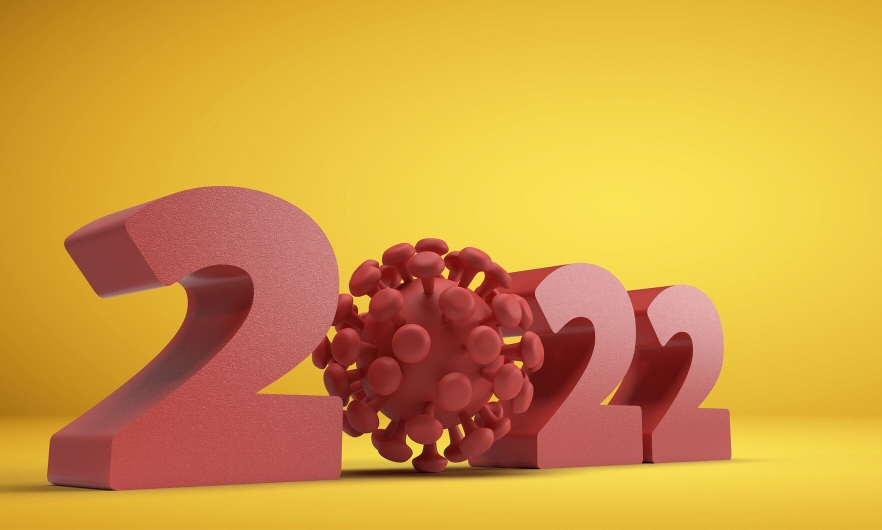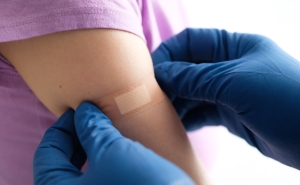COVID-19 in 2022: A Year-End Wrap-Up
At the conclusion of the pandemic’s third year, a look back—and forward.

Omicron overstayed its welcome. At-home COVID-19 testing was routine. The bivalent booster arrived.
The past 12 months also saw the U.S. surpass more than a million total COVID deaths, vaccine authorizations for very young children, and a year-end tripledemic.
As year three of the COVID-19 era draws to a close, we asked some of the School’s pandemic experts to weigh in on the good, the bad, and the unknown of COVID-19 in 2022, and share their greatest hope—COVID-wise—for 2023.
The Good
In 2022, COVID-19 illness was less severe and less deadly compared to 2020 and 2021, and no new variant has emerged with the capacity to fuel a major wave of cases. Contributing factors to these positive developments:
- Unprecedented advances in vaccine technology that allow for rapid updates to protect against new strains.
- A more effective treatment and prevention toolbox of vaccines and boosters, oral antivirals, and home test kits.
- Growing population immunity to the virus.
“Mortality and illness from COVID-19 now looks a lot more like that of influenza, concentrated in older age groups and on the same order of magnitude, and there is hope that as our immune systems see this virus even more, illness will continue to get milder,” says Epidemiology professor David Dowdy, MD, PhD ’08, ScM ’02.
COVID became less of a disruption in our lives, making it possible to resume pre-pandemic activities like travel, attending large events, and going to school in person and unmasked.
“We have built enough immunity to COVID to allow life to return to normal in many ways without huge surges in the number of deaths any longer,” says Epidemiology professor Gypsyamber D’Souza, PhD ’07, MPH, MS.
Amesh Adalja, MD, senior scholar with the Center for Health Security, maintains that “people have, for the most part, learned to risk calculate and navigate a world with an unavoidable new virus.”
This year has also demonstrated that COVID has permanently altered how and where we work.
“There have been societal changes in work-from-home and hybrid-work availability that are positive for many individuals,” says D’Souza.
The Bad
In January and February, the U.S. was in the midst of the initial omicron wave. (The variant emerged in late 2021.) “At its peak, the wave involved the highest weekly number of [COVID-19] cases and nearly the highest weekly number of deaths of the entire pandemic,” says Dowdy.
“Neither vaccination nor having had COVID reduced chances of reinfection as much as we would like, and we will continue to see high transmission this winter,” says D’Souza. “Although risk of severe illness is much lower, many people have symptoms that keep them in bed for days feeling quite unwell.”
Also in the negative column: continued COVID misinformation, particularly around vaccines, with “follow-on consequences for regular childhood vaccinations,” says Tara Kirk Sell, PhD, MA, senior scholar with the Center for Health Security; underutilization of the antiviral medication Paxlovid; clear evidence of pandemic fallout in other aspects of our lives and in society as a whole, including increased rates of mental illness especially among adolescents, “higher levels of opioid overdose, [and] educational shortfalls,” Dowdy says.
The Unknown
Experts agree that China’s relaxing of two years of zero-COVID policies tops their list of unknowns. Outbreaks are occurring across the country, and hospitals report being overwhelmed as COVID and flu collide.
Says Dowdy: “More than one-sixth of the world’s population lives in China. … We could see a huge wave of COVID-19 in the next few months, as levels of immunity there are much lower.”
Some other key questions and concerns:
“Will public health departments be able to maintain the badly needed skills and expertise they were able to gain during the pandemic?” Sell asks. “Almost every public health department leader I’ve spoken to in the past few weeks is stressing about being able to keep staff.”
D’Souza notes: “It’s unclear how well the new bivalent boosters protect against current strains—and since many people have had COVID this summer or fall, it’s unclear whether they would benefit from boosting. How long to wait after having had COVID before getting the booster is not well understood.”
Another unknown, says Amesh Adalja, is “how COVID impacts the circulation of other respiratory viruses and overall mortality from pneumonia and influenza, over the long term.”
Hopes for 2023
Tara Kirk Sell: “I hope that COVID-19 will be relegated to a normal public health concern—something like how we work to protect people from flu, car accidents, suicides, heart disease. It probably won’t ever disappear, but it can be something we can manage going forward.”
Amesh Adalja: “Universal vaccines, better antivirals, new monoclonal antibodies, handling COVID like other respiratory viruses.”
Gypsyamber D’Souza: “My hope is that most people feel their lives are back to normal and that there is less stress and concern about whether to be able to travel, see family and friends, and attend large gatherings.”
David Dowdy: “My hope is that 2023 will be the year where we truly feel like our lives are getting back to normal. Life will never be completely the same, and we will be dealing with the aftermath of the pandemic for many years to come. But I hope that by the end of 2023, COVID-19 and its after-effects won’t even crack most people’s ‘top 10 problems in my life right now.’ That would be a huge public health success.”
Jackie Powder is the assistant editor of Hopkins Bloomberg Public Health magazine.





